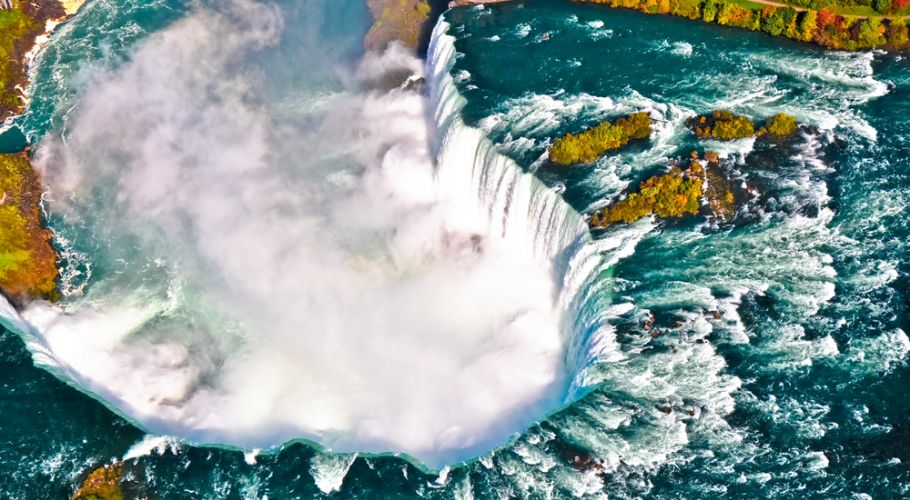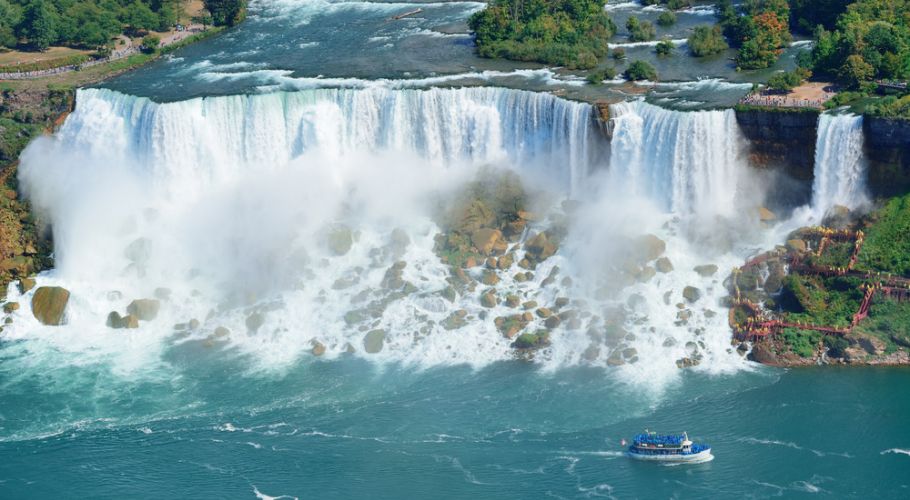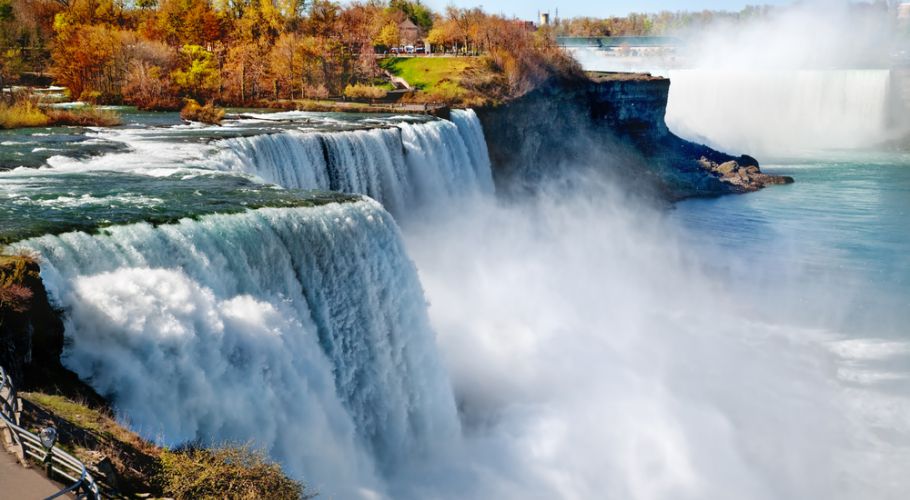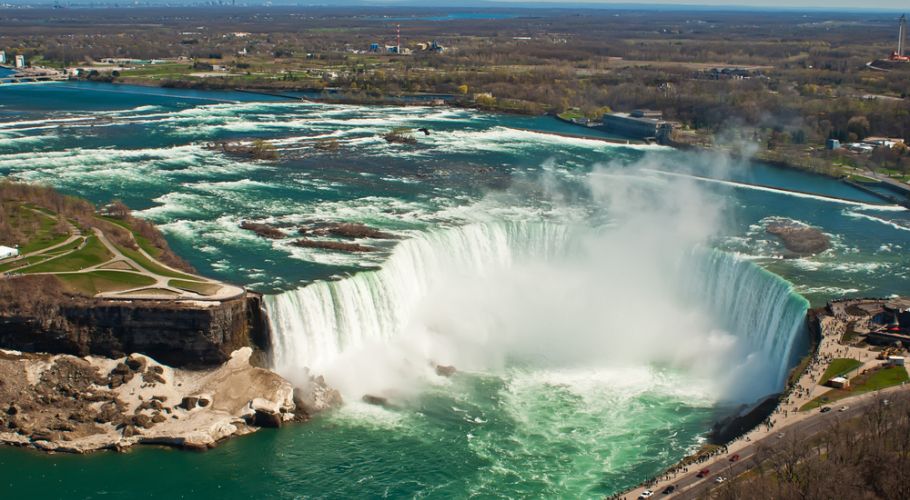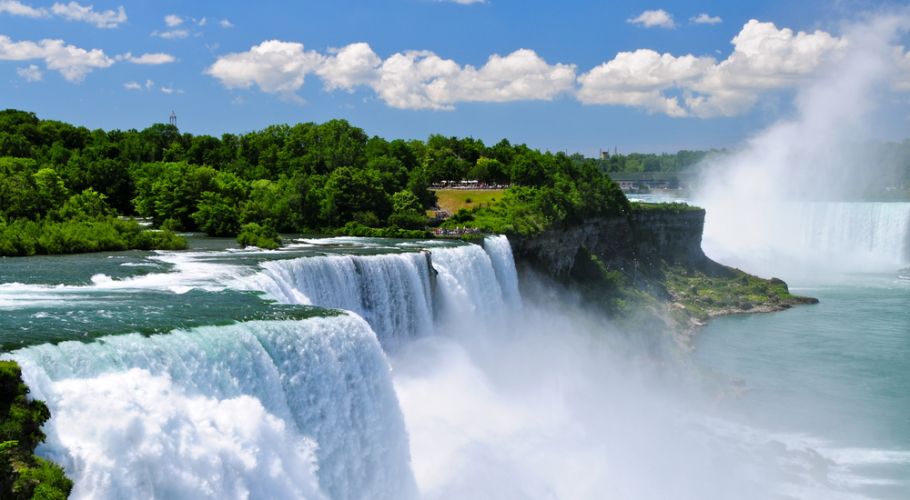Niagara Falls is located on the border between Canada and the United States. Niagara is comprised of three separate falls which include Horseshoe Falls, the American Falls and the Bridal Veil Falls.
Experts in conservation and nature from around the world including members of the International Union for the Conservation of Nature voted on the natural wonders of North America. On February 26, 2014 following the conclusion of the voting, Niagara Falls was declared one of the Seven Natural Wonders of North America.
You are invited to discover and explore Niagara Falls and learn what makes it one of North America’s Seven Wonders of Nature.
What makes Niagara Falls a natural wonder?
Statistically speaking, Niagara Falls is recognized as having the greatest flow rate of any waterfall throughout the globe. The falls have more than six million cubic feet (168,000 cubic meters) flow over the top of the falls every minute during the peak season. The average is still impressive with approximately four million cubic feet (110,000 cubic meters) cross over the top of the falls every minute.
Horseshoe Falls is the most powerful waterfall in the entire continent. This is the largest of the three falls that comprise together to create Niagara Falls. Horseshoe Falls has a drop of 173 feet (53 m), and it extends 2,600 feet (790 m) across. The American Falls greatest drop is 100 feet (30 m), however it varies because of boulders located along the bottom. This falls reaches 1,060 (320 m) across. Horseshoe Falls accounts for 90% of the water going over the three falls that make up Niagara Falls.
Niagara Falls is supported by sister cities in Canada and the United States. Niagara Falls, Ontario and Niagara Falls, New York both provide protection and tourism services that support the falls.
What are the best ways to see and experience Niagara Falls?
The best way to see and experience Niagara Falls is by leveraging the various overlooks provided by both Canada and the United States. A visit to one side or the other is an incomplete experience of one of the world’s greatest wonders.
Canadian Side
The Canadian side provides the greater panoramic views and is essential for truly grasping the magnitude of the falls. Queen Victoria Park features colorful gardens that complement the various platforms and views of the American and Horseshoe Falls. The Skylon Tower provides visitors with the highest overhead view of the falls.
Another highlight is the Whirlpool Aero Car that carries visitors over the Niagara Whirlpool on the Canadian side. Combine this with the Journey Behind the Falls, a series of tunnels and a platform near the base of Horseshoe Falls on the Canadian side and you will have a fairly eclectic and comprehensive experience of Niagara Falls.
The Canadian side also features a 35 mile (56 km) trail, Niagara River Recreational Trail, that extends from Fort Erie and Fort George. This provides scenic views of the falls, the river and other historical sites from the War of 1812. This adds a historical and cultural facet to your wonder of North America experience.
American Side
The American side features a railed spot, Prospect Point Park, just a few short feet away from the falls that allows visitors to stand right next to the falls and gather an idea of the power of the flow over the falls. Visitors can cross the bridge over to Goat Island and gather new perspectives of the falls. Hikers can also take an elevator down beneath Bridal Veil Falls.
The elevator on Goat Island also provides visitors access to the dock for touring the waterways on the Maid of the Mist. This boat ventures out into the river and base of the falls providing a spectacular view of the falls from below. The Maid of the Mist ventures into the mist and falling water allowing travelers an opportunity to witness the powerful flow of the falls. Visitors are guaranteed to get wet and not just wet, we mean soaked.
A highlight should be experience the panoramic and aerial views provided from a balloon or helicopter tour over the falls. Combined with the other attractions and views of the falls, and you should have a comprehensive experience of the falls.
When is the best time to visit Niagara Falls?
The best time to see Niagara Falls is during the summer months of June through September. During these months the falls are a full day attraction. The Canadian side illuminates both sides of the falls through most of the evening. This is an aesthetically pleasing enhancement adding a whole different perspective of the falls.
Niagara Falls is accessible year round and worth the experience. During the winter months, the falls managment may be diverting some of the water flow for a power source. This is usually done in the evening seeking to provide visitors with the best falls experience possible.
Late September and into October is a nice time to visit with the fall foliage adding brilliant colors to the already stunning falls. The weather can be chillier, but this is still a good time to visit Niagara Falls.
What is Niagara Falls weather like?
Yellowstone National Park weather varies throughout the year. The summer months of June through September typically sees the high temperatures ranging from 70 to 80oF (21 to 27oC) during the day and evening temperatures ranging dropping close to freezing. The Spring and Fall temperatures are cooler with temperatures ranging from 30 to 60oF(-1 to 16oC).
The summer months can easily experience afternoon rains or thunderstorms, but these usually clear out fairly fast. A nice thunderstorm with lightning across the Yellowstone caldera and surrounding mountains can make for a picturesque scene. The winter months bring snow and temperatures below freezing throughout the day.
Photography Tips for capturing Niagara Falls
As would be expected, photographers should plan to visit both the Canadian and American sides of the falls. Each provides varying views and perspectives of the falls. A wide angle lens will be helpful in capturing the expanse of the falls.
If you take the Maiden of the Mist, it is imperative that you take protective gear. It is not a matter of if you get wet, but rather how soaked you get. It would be worthwhile to take a waterproof camera to capture those images.
If you are a photographer and you have tips or insights for capturing images at Yellowstone National Park, please submit them to Seven Wonders through the Contact page
